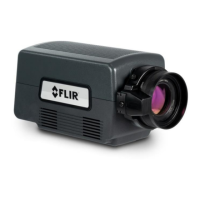5 –Camera Controller
A6000 and A8500 Series User’s Manual
51
5.5.5.1.1 Two-Point Correction Process
The Two-Point Correction Process builds a NUC table that contains an individually computed gain
and offset coefficient for each pixel as seen in Figure 4-14. Two uniform sources are required for this
correction. One source at the low end and a second source at the upper end of the usable detector
input range. Because of the use of two images at either end of the input range, the Two-Point
Correction yields better correction results. A two-point correct will also work better over a wider range
of scene temperatures.
Figure 4-14: Two-Point Correction
5.5.5.1.2 Offset Update
Often during the normal operation of a camera, the electronics and/or optics will heat up or cool down
which changes the uniformity of the camera image. This change requires a new NUC. However, this
change is mainly in the offset response of the image while the gain component stays constant. An
Offset Update simply computes a new offset coefficient using the existing gain coefficient and corrects
the image non-uniformity. Offsets Update are typically performed when a Two-Point NUC table is
being used.
An Offset Update requires only one uniform source, usually set at a temperature on the lower edge of
the operational range.

